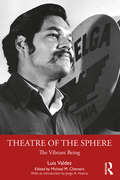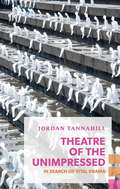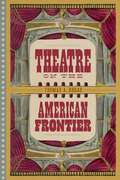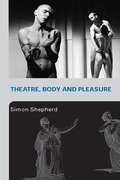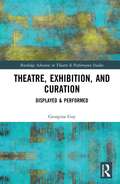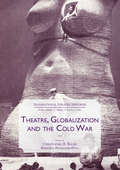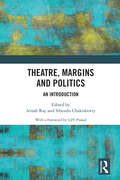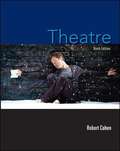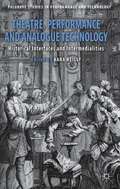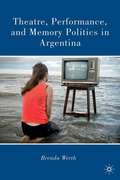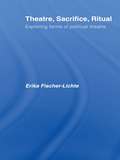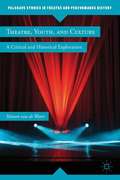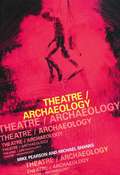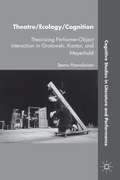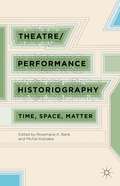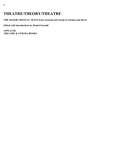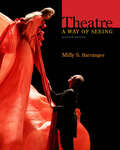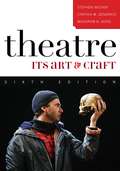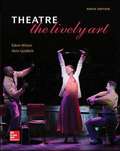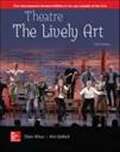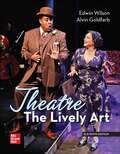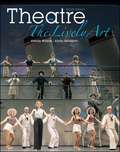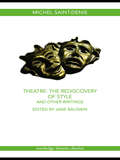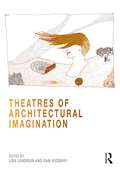- Table View
- List View
Theatre of the Sphere: The Vibrant Being
by Luis ValdezTheatre of the Sphere is Luis Valdez’s exploration of the principles that underlie his innovations as a playwright, teacher, and theatrical innovator. He discusses the unique aesthetic, more than five decades in the making, that defines the work of his group El Teatro Campesino—from shows staged on the backs of flatbed trucks by the participants in the Delano Grape Strike of the 1960s to international megahits like Zoot Suit. Opening with a history of El Teatro Campesino, rich with Valdez’s insights and remembrances, the book’s first part provides context for the development of the Theatre of the Sphere acting method. The second part delivers the conceptual framework for Valdez’s acting theory and practice, situating it in Mayan mathematics and metaphysics. The third part of the book applies this methodology to describe the "viente pasos," the 20-element exercise sequence that comprises the core practice of El Teatro Campesino—strengthening the body, balance, precision, and flexibility but also leadership, collaboration, observation, vulnerability, trust, and expression of passion; of consciousness of time, place, self, community, language, and belief; of honour, faith, morality, and commitment. The book concludes with the full text of Valdez’s poem, "El Buen Actor/El Mal Actor," and a comprehensive bibliography for further study. This is a vital and indispensable text for today’s actor, as well as scholars and students of contemporary theatre, American and Chicano performance, and the process of theatre-making, actor training, and community performance.
Theatre of the Unimpressed
by Jordan TannahillA lot of plays are bad. And one bad play, it seems, can turn us off theater for good. So, what can we learn from the bad play? Jordan Tannahill, after talking to theater heavy-hitters from Australia to Berlin, offers a roadmap for a renewed theater, one that is less insular, less insulting, with better infrastructure. In reconsidering dramaturgy, programming strategies, and alternative models for producing, he aims to turn theater from an obligation to a destination.Jordan Tannahill is a multidisciplinary artist based in Toronto. His production of Sheila Heti's All Our Happy Days Are Stupid will be performed in New York in 2015.
Theatre of the Unimpressed
by Jordan TannahillHow dull plays are killing theatre and what we can do about it. Had I become disenchanted with the form I had once fallen so madly in love with as a pubescent, pimple-faced suburban homo with braces? Maybe theatre was like an all-consuming high school infatuation that now, ten years later, I saw as the closeted balding guy with a beer gut he'd become. There were of course those rare moments of transcendence that kept me coming back. But why did they come so few and far between? A lot of plays are dull. And one dull play, it seems, can turn us off theatre for good. Playwright and theatre director Jordan Tannahill takes in the spectrum of English-language drama - from the flashiest of Broadway spectacles to productions mounted in scrappy storefront theatres - to consider where lifeless plays come from and why they persist. Having travelled the globe talking to theatre artists, critics, passionate patrons and the theatrically disillusioned, Tannahill addresses what he considers the culture of 'risk aversion' paralyzing the form. Theatre of the Unimpressed is Tannahill's wry and revelatory personal reckoning with the discipline he's dedicated his life to, and a roadmap for a vital twenty-first-century theatre - one that apprehends the value of 'liveness' in our mediated age and the necessity for artistic risk and its attendant failures. In considering dramaturgy, programming and alternative models for producing, Tannahill aims to turn theatre from an obligation to a destination. '[Tannahill is] the poster child of a new generation of (theatre? film? dance?) artists for whom "interdisciplinary" is not a buzzword, but a way of life.'- J. Kelly Nestruck, The Globe and Mail 'Jordan is one of the most talented and exciting playwrights in the country, and he will be a force to be reckoned with for years to come.'- Nicolas Billon, Governor General's Award-winning playwright (Fault Lines)
Theatre on the American Frontier
by Thomas A. BogarFor two centuries, nearly all historical accounts of American theatre have focused on New York, Boston, and Philadelphia. As a result, the story of theatre on the frontier consists primarily of regional studies with limited scope. Thomas A. Bogar’s Theatre on the American Frontier provides an overdue, balanced treatment of the accomplishments of the troupes working in the trans-Appalachian West.From its origins in late eighteenth-century Pittsburgh, New Orleans, and Louisville, frontier theatre grew by the close of the nineteenth century to encompass more than a dozen centers of vibrant theatrical activity. Audiences—mainly pioneers struggling with the hardships of establishing a life in the backcountry—enjoyed thrilling melodramas, the comedies of George Colman the Younger and John O’Keeffe, and even the tragedies of William Shakespeare. Theatre companies that ventured into this challenging and unfamiliar territory did so with a combination of daring and determination. Bogar’s comprehensive study brings this neglected history into the spotlight, cementing these figures and their theatrical productions and practices in their rightful place.
Theatre, Body and Pleasure
by Simon ShepherdBreaking new ground in the study of performance theory, this maverick and powerful project from renowned Renaissance scholar and queer theorist Simon Shepherd presents a unique take on theory and the physical reality of theatre. Examining a range of material, Theatre, Body, Pleasure addresses a significant gap in the literary and drama studies arenas and explores the interplay of bodily value, the art of bodies and the physical responses to that art. It explains first how the body makes meaning and carries value. Then it describes the relationships between time and space and body. The book’s features include: * large historical range, from medieval to postmodern * case studies offering close readings of written texts * examples of how to ‘read for the body’, exploring written text as a ‘discipline’ of the body * breadth of cultural reference, from stage plays through to dance culture * a range of theoretical approaches, including dance analysis and phenomenology Writing in accessible prose, Shepherd introduces new ways of analyzing dramatic text and has produced a book which is part theatre history, part dramatic criticism and part theatrical tour de force. Students of drama, theatre and performance studies and cultural studies will find this an absolute must read.
Theatre, Exhibition, and Curation: Displayed & Performed (Routledge Advances in Theatre & Performance Studies)
by Georgina GuyExamining the artistic, intellectual, and social life of performance, this book interrogates Theatre and Performance Studies through the lens of display and modern visual art. Moving beyond the exhibition of immaterial art and its documents, as well as re-enactment in gallery contexts, Guy's book articulates an emerging field of arts practice distinct from but related to increasing curatorial provision for ‘live’ performance. Drawing on a recent proliferation of object-centric events of display that interconnect with theatre, the book approaches artworks in terms of their curation together and re-theorizes the exhibition as a dynamic context in which established traditions of display and performance interact. By examining the current traffic of ideas and aesthetics moving between theatricality and curatorial practice, the study reveals how the reception of a specific form is often mediated via the ontological expectations of another. It asks how contemporary visual arts and exhibition practices display performance and what it means to generalize the ‘theatrical’ as the optic or directive of a curatorial concept. Proposing a symbiotic relation between theatricality and display, Guy presents cases from international arts institutions which are both displayed and performed, including the Tate Modern and the Guggenheim, and assesses their significance to the enduring relation between theatre and the visual arts. The book progresses from the conventional alignment of theatricality and ephemerality within performance research and teases out a new temporality for performance with which contemporary exhibitions implicitly experiment, thereby identifying supplementary modes of performance which other discourses exclude. This important study joins the fields of Theatre and Performance Studies with exciting new directions in curation, aesthetics, sociology of the arts, visual arts, the creative industries, the digital humanities, cultural heritage, and reception and audience theories.
Theatre, Globalization and the Cold War
by Christopher B. Balme Berenika Szymanski-DüllThis book examines how the Cold War had a far-reaching impact on theatre by presenting a range of current scholarship on the topic from scholars from a dozen countries. They represent in turn a variety of perspectives, methodologies and theatrical genres, including not only Bertolt Brecht, Jerzy Grotowski and Peter Brook, but also Polish folk-dancing, documentary theatre and opera production. The contributions demonstrate that there was much more at stake and a much larger investment of ideological and economic capital than a simple dichotomy between East versus West or socialism versus capitalism might suggest. Culture, and theatrical culture in particular with its high degree of representational power, was recognized as an important medium in the ideological struggles that characterize this epoch. Most importantly, the volume explores how theatre can be reconceptualized in terms of transnational or even global processes which, it will be argued, were an integral part of Cold War rivalries.
Theatre, Margins and Politics: An Introduction
by Arnab Ray Sibendu ChakrabortyThis book interrogates the relationship of theatre and the dialectics of centre and the margins. It looks into the exciting world of performance to examine how theatre as an art form is perfectly placed to both perform and critique complex relations of power, politics and culture. The volume looks into how drama has historically served as a stage for expressing and showcasing prevalent social, historical, and cultural contexts from which it has emerged or intends to critique. Including a wide range of performative practices like Dalit theatre, Australian Aboriginal theatre, Western realism and Yoruba theatre, it explores varied lived experiences of people, and voices of subversion, subalternity, resistance and transformation. The book scrutinizes the strategies of representation enunciated through textuality, theatricality and performance in these works and the politics they are inextricably linked with. This book will be of interest and use to scholars, researchers, and students of theatre and performance studies, postcolonial studies, race and inequality studies, gender studies, and culture studies.
Theatre, Ninth Edition
by Robert CohenThis lively introduction to theatre offers equal measures of appreciation of theatrical arts, history of performance, and descriptions of the collaborative theatrical crafts. The author’s enthusiasm for and knowledge of the current theatre, highlighted by contemporary production shots from around the world, put the students in the front row. The text includes extensive excerpts from seven plays: Prometheus Bound, Oedipus Tyrannos, The York Cycle, Romeo and Juliet, The Bourgeois Gentleman, The Three Sisters, and Happy Days, as well as shorter excerpts from The Rover and A Doll's House.
Theatre, Performance And Analogue Technology
by Kara ReillyThis trans-historical collection explores analogue performance technologies from Ancient Greece to pre-Second World War. From ancient mechanical elephants to early modern automata, Enlightenment electrical experiments to Victorian spectral illusions, this volume offers an original examination of the precursors of contemporary digital performance.
Theatre, Performance, and Memory Politics in Argentinay
by Brenda WerthSince Argentina's transition to democracy, the expression of human fragility on the stage has taken diverse forms. This book examines the intervention of theatre and performance in the memory politics surrounding Argentina's return to democracy and makes a case for performance's transformative power.
Theatre, Sacrifice, Ritual: Exploring Forms of Political Theatre
by Erika Fischer-LichteIn this fascinating volume, acclaimed theatre historian Erika Fischer-Lichte reflects on the role and meaning accorded to the theme of sacrifice in Western cultures as mirrored in particular fusions of theatre and ritual. Theatre, Sacrifice, Ritual presents a radical re-definition of ritual theatre through analysis of performances as diverse as: Max Reinhardt's new people's theatre the mass spectacles of post-revolutionary Russia American Zionist pageants the Olympic Games. In offering both a performative and a semiotic analysis of such performances, Fischer-Lichte expertly demonstrates how theatre and ritual are fused in order to tackle the problem of community-building in societies characterised by loss of solidarity and disintegration, and exposes the provocative connection between the utopian visions of community they suggest, and the notion of sacrifice. This innovative study of twentieth-century performative culture boldly examines the complexities of political theatre, propaganda and manipulation of the masses, and offers a revolutionary approach to the study of theatre and performance history.
Theatre, Youth, and Culture
by Manon van de WaterThere is a complex relationship between performance, youth, and the shifting material circumstances (social, cultural, economic, ideological, and political) under which theatre for children and youth birth through twenties is generated and perceived. Offering multiple, intersecting narratives, this book explores different aspect of theatre for young audiences (TYA) using examples from theatrical events in different geographical regions. The discussion of the history, theory, and practice of TYA indicates the wide variety of hitherto under-researched topics in the growing field of professional theatre for young people. "
Theatre/Archaeology: An Imperfect Archaeology
by Michael Shanks Mike PearsonTheatre/Archaeology is a provocative challenge to disciplinary practice and intellectual boundaries. It brings together radical proposals in both archaeological and performance theory to generate a startlingly original and intriguing methodological framework.
Theatre/Ecology/Cognition
by Teemu PaavolainenHow is performer-object interaction enacted and perceived in the theatre? How thereby are varieties of 'meaning' also enacted and perceived? Using cognitive theory and ecological ontology, Paavolainen investigates how the interplay of actors and objects affords a degree of enjoyment and understanding, whether or not the viewer speaks the language.
Theatre/Performance Historiography
by Michal Kobialka Rosemarie K. BankHow do the ethical implications of writing theatrical histories complicate the historiographical imperative in our current sociopolitical context? This volume investigates a historiography whose function is to be a mode of thinking and exposes the inner contradictions in social and ideological organizations of historical subjects.
Theatre/Theory/Theatre: The Major Critical Texts From Aristotle and Zeami to Soyinka and Havel (Applause Books)
by Daniel GerouldFrom Aristotle's Poetics to Vaclav Havel, the debate about the nature and function of theatre has been marked by controversy. Daniel Gerould's landmark work, Theatre/Theory/Theatre, collects history's most influential Eastern and Western dramatic theorists—poets, playwrights, directors and philosophers—whose ideas about theatre continue to shape its future. <p><p>In complete texts and choice excerpts spanning centuries, we see an ongoing dialogue and exchange of ideas between actors and directors like Craig and Meyerhold, and writers such as Nietzsche and Yeats. Each of Gerould's introductory essays shows fascinating insight into both the life and the theory of the author. From Horace to Soyinka, Corneille to Brecht, this is an indispensable compendium of the greatest dramatic theory ever written.
Theatre: A Way of Seeing
by Milly S. BarrangerConsistently praised as "streamlined" and "clear and student friendly," THEATRE: A WAY OF SEEING offers the beginning theatre student an exciting, full-color introduction to all aspects of theatre. It presents the experience of theatre, who sees it, what is seen, and where and how it is seen largely from the viewpoint of audiences exposed to a complex, living art that involves people, spaces, plays, designs, staging, forms, language, and productions. The book includes the appropriate coverage of the history, diversity, and most critical moments in theatre in a way that encourages students to experience theatre as "a performing art and humanistic event."
Theatre: Its Art and Craft
by Stephen Archer Cynthia M. Gendrich Woodrow B. HoodTheatre: Its Art and Craft is an introductory theatre text focusing on theatre practitioners and their processes. Using an accessible tone and a focused exploration of how theatre artists work, the book covers playwrights, directors, actors, designers of sets, costumes, props, lights, sound, and new technology, as well as the varying roles of scholars, critics, and dramaturgs. Appropriate for beginning theatre majors, minors, or non-majors, Theatre: Its Art and Craft helps students understand how theatre happens, who makes it, and what they do. Updated with new statistics, references, and photographs, the sixth edition now features an overhauled design section: the authors have divided the design chapter into two parts: one focused on the tactile elements of design (sets, costumes, props) and the second on the temporal elements (lights, sound, and new technologies).
Theatre: The Lively Art
by Edwin Wilson Alvin GoldfarbIn its ninth edition, Theatre: The Lively Art remains the best-selling program for Theatre Appreciation courses. With its hallmark focus on preparing future audience members, students will learn how theatre functions, how it should be viewed and judged, and the tradition behind any performance they may attend.
Theatre: The Lively Art
by Edwin Wilson Alvin GoldfarbTheatre: The Lively Art remains the best-selling program for Theatre Appreciation courses. With its hallmark focus on preparing future audience members, students will learn how theatre functions, how it should be viewed and judged, and the transition behind any performance they may attend.
Theatre: The Lively Art
by WilsonSeveral qualities set Theatre: The Lively Art apart from other introductory texts. A particularly important element is our emphasis on the audience. All students reading the book are potential theatregoers, not just during their college years but throughout their lives. We have therefore attempted to make This new edition is an ideal one-volume text to prepare students as future audience members. It will give them a grasp of how theatre functions, of how it should be viewed and judged, and of the tradition behind any performance they may attend. Lively Art allows instructors to focus on both the elements of the theatre and the history of the theatre. It also focuses on today's diverse and global theatre. In addition to serving as an ideal text for nonmajors, Theatre: The Lively Art will prepare students who wish to continue studies in theatre, as majors, minors, or students from other disciplines who take advanced courses.
Theatre: The Lively Art (8th Edition)
by Edwin Wilson Alvin GoldfarbTheatre: The Lively Art will provide the background to theatre and it will encourage and inspire students to become lifelong audience members, if not actual theatre artists.
Theatre: The Rediscovery of Style and Other Writings
by Michel Saint-DenisMichel Saint-Denis was one of twentieth century theatre’s most influential directors and theorists. This book combines his seminal Theatre: The Rediscovery of Style with material from Training for the Theatre, newly edited to create a work which moves seamlessly from theory to practice. Theatre: The Rediscovery of Style collects five of Saint Denis’ key lectures, given during his time in America, and perfectly encompasses his synergy of classical theatre and modern realism Training for the Theatre is a key practical resource for actors, directors and teachers alike. It covers crucial areas such as understanding a play’s context, training schedules, improvisation and dealing with stage space, as well as a section on Saint-Denis’ use of masks in actor training Theatre: The Rediscovery of Style and Other Writings benefits from Jane Baldwin’s new biographical introduction and annotations, that put Saint-Denis into context for a contemporary audience. It brings a wealth of inspirational material both to the rehearsal space and the classroom.
Theatres of Architectural Imagination
by Lisa LandrumThis volume explores connections between architecture and theatre, and encourages imagination in the design of buildings and social spaces. Imagination is arguably the architect’s most crucial capacity, underpinning memory, invention, and compassion. No simple power of the mind, architectural imagination is deeply embodied, social, and situational. Its performative potential and holistic scope may be best understood through the model of theatre. Theatres of Architectural Imagination examines the fertile relationship between theatre and architecture with essays, interviews and entr’actes arranged in three sections: Bodies, Settings, and (Inter)Actions. Contributions explore a global spectrum of examples and contexts, from ancient Rome and Renaissance Italy to modern Europe, North America, India, Iran, and Japan. Topics include the central role of the human body in design; the city as a place of political drama, protest, and phenomenal play; and world-making through language, gesture, and myth. Chapters also consider sacred and magical functions of theatre in Balinese and Persian settings; eccentric experiments at the Bauhaus and 1970 Osaka World Expo; and ecological action and collective healing amid contemporary climate chaos. Inspired by architect and educator Marco Frascari, the book performs as a Janus-like memory theatre, recalling and projecting the architect’s perennial task of reimagining a more meaningful world. This collection will delight and provoke thinkers and makers in theatrical arts and built environment disciplines, especially architecture, landscape, and urban design.
